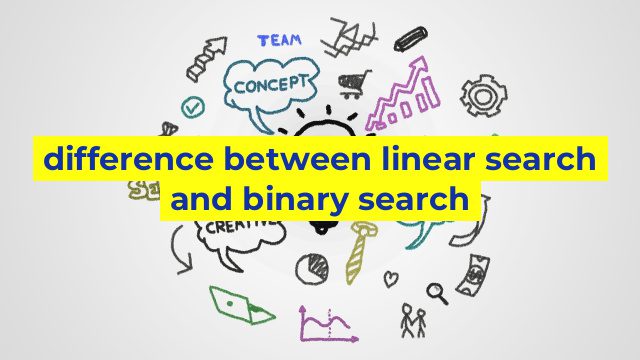The Difference Between Linear Search and Binary Search
When it comes to searching for data in computer science, there are two methods that stand out – linear search and binary search. Both these methods serve the same purpose, but they differ significantly in terms of how they operate. Understanding the difference between linear and binary search can help you choose the best method for your problem.
Linear Search Explained
Linear search, also known as sequential search, is a straightforward search algorithm that works by checking each element of an array in sequence until the desired element is found. In other words, it starts from the beginning and compares each element to the target value until it finds a match or reaches the end of the list.
Linear search is easy to understand and implement, and it works well for small data sets or unsorted arrays. However, its main disadvantage is its time complexity. The worst-case scenario for linear search is that it would have to compare every element in the list. Therefore, the time complexity of linear search is O(n), where n is the number of elements in the array.
Binary Search Explained
Binary search, on the other hand, is a more complex search algorithm that relies on dividing the array in half and eliminating half of the remaining elements at each iteration. In binary search, the array must be sorted before the search begins.
Binary search starts from the middle element of the array and compares it to the target value. If the value is less than the middle element, the search continues in the left half of the array; if it is greater, the search continues in the right half. This process is repeated until the target value is found, or the remaining array contains no more elements.
Due to its divide-and-conquer approach, binary search is much faster than linear search. In the worst case, the time complexity of binary search is O(log n), where n is the number of elements in the array. This makes it a better choice for large data sets or sorted arrays.
Conclusion
In summary, the difference between linear search and binary search lies in their time complexity and performance. Linear search is simple and easy to understand, but it is inefficient for large data sets. Binary search, on the other hand, requires more initial work to sort the array, but it is much faster and efficient in the long run.
Therefore, when deciding between linear search and binary search, consider the size of your data set, whether it is sorted or unsorted, and the desired speed of the search algorithm. By understanding the differences between these two methods, you can choose the one that is best suited for your problem.
Table difference between linear search and binary search
| Linear Search | Binary Search |
|---|---|
| Searches an unsorted or a sorted array | Searches only in a sorted array |
| Time complexity is O(n) | Time complexity is O(log n) |
| Uses a sequential approach to find an element | Uses a divide and conquer approach to find an element |
| Can search any type of array or list | More suitable for homogeneous elements |
| May take longer to find an element in larger arrays | Faster than linear search for larger arrays |

